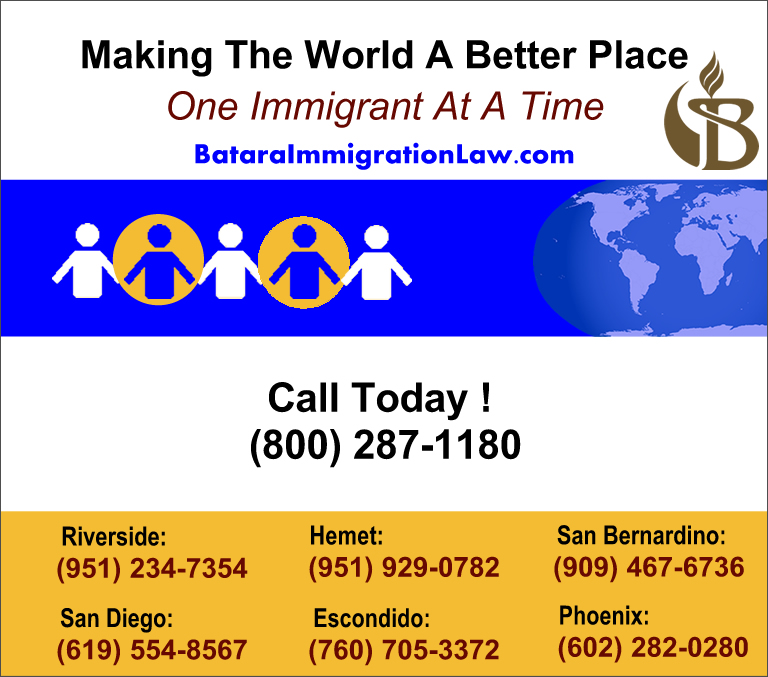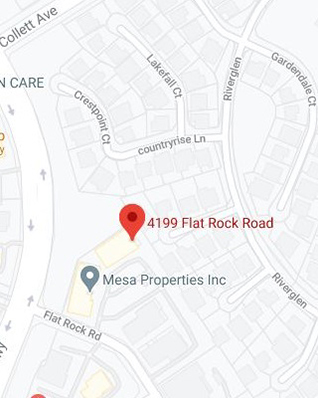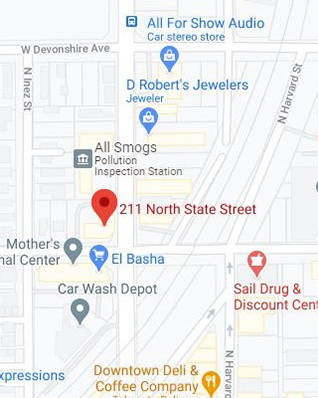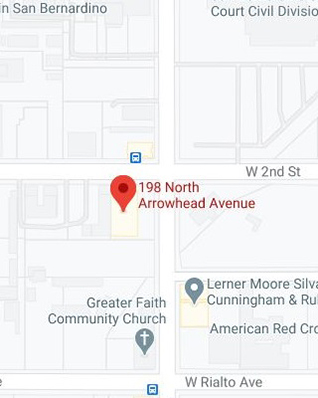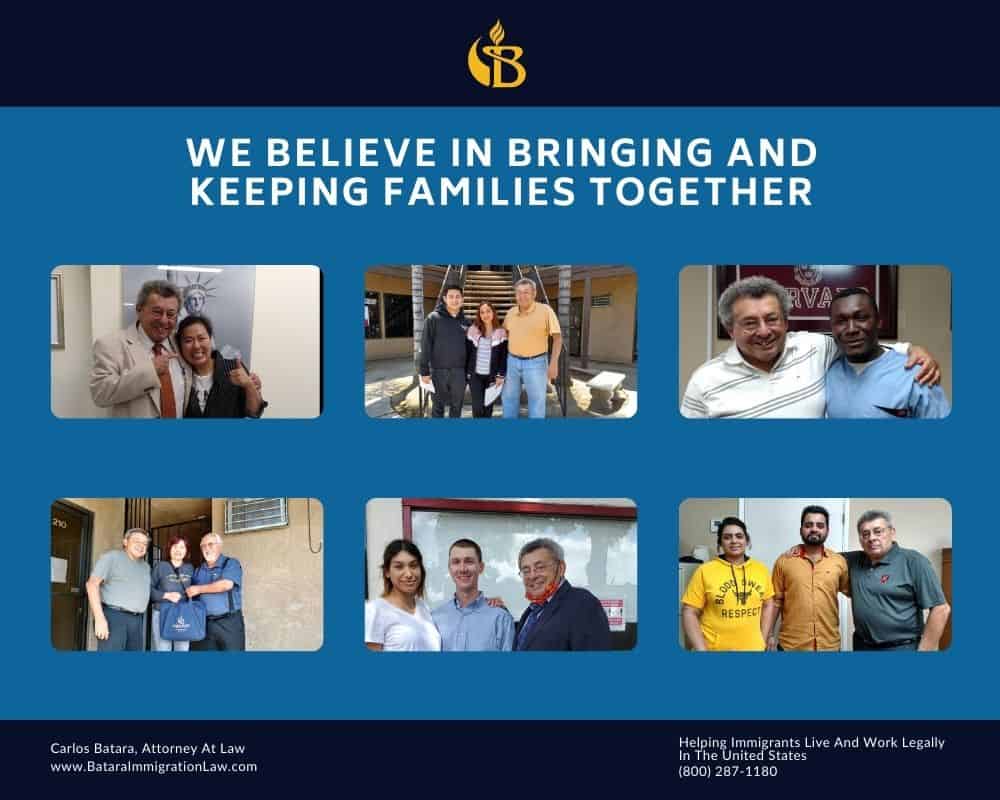
Despite The Obstacles Ahead, Permanent Residence Is Possible . . .
Living And Working Legally In The U.S. May Be Closer Than You Think
Winning a green card and being able to live in the United States is difficult. But it is more possible than many immigrants realize. In this article, you’ll learn 11 insights essential to helping your family and relatives win lawful permanent residence in the United States.
11 Insights You Should Know About Winning Permanent Residence (Here And Abroad)
At times, the road to permanent residence for your family looks bleak and hopeless.
Some immigrants wonder if they should give up, pack up their suitcase, and move back to their home country.
For instance:
- Maybe friends told you that you will never qualify for permanent residence because you entered the U.S. without permission.
- Perhaps a paralegal or notario said that you cannot sponsor your daughter does not qualify for a green card because she is now over 21 years old.
- Or you were told by other attorneys that you bring your mother, living overseas, into the United States because ten years ago, she stayed in the U.S. past her tourist visa expiration date.
Such advice could be wrong – 100% wrong.
This is why we help immigrants and their families clarify their road ahead, good and bad, and figure out which path offers the best chance for success.
Before they begin their green card journey.
You should never, never, never believe the worst about the chances for success – until and unless you have exhausted all of your possibilities to earn legal residency.
You owe it to yourself . . . and your family . . . to find out more about what options may exist for immigration victory before giving up.
For instance, if you’re like most of our clients:
- You do not want to be separated, perhaps forever, from your husband or wife
- You do not want your children growing up without both of their parents
- You do not want to see your dreams of a better life – a better job, a secure home, and the freedom to travel – destroyed
You owe it to yourself . . . and your immigrant family relatives . . . to keep believing keep believing in your goals of a better life tomorrow.
And we’re here to help you achieve those goals.
Green Cards For Your Family Members
- Family Immigration Green Cards For Spouses
- Family Immigration Green Cards For Parents
- Family Immigration Green Cards For Children
- Family Immigration Green Cards For Brothers And Sisters
Table Of Contents
-
- What Is A Green Card?
- The Family-Based Permanent Resident Process For Immigrant Relatives
- What Is The Priority Date?
- Two Paths To Green Cards: Adjustment Of Status And Consular Processing
- Are There Any One-Step Adjustment Of Status Permanent Residence Applications?
- Visas vs Green Cards: What Is The Difference?
- Permanent Residence For Immigrant Children Of Your Spouse
- What Happens While Your Permanent Residence Application Is Pending?
- What Happens If You Win A Green Card As A Conditional Permanent Resident?
- After Becoming A Permanent Resident, When Can You File For U.S. Citizenship?
- What If Your Permanent Residence Application Is Denied?
- Conclusion: How To Avoid Stumbling Blocks That Affect Permanent Residence Success
1. What Is A Green Card?
The term “Green Card” refers to the document given to immigrants who have become lawful permanent residents – that is, who have been granted the right to live and work legally in the United States.
“Green Card” is not the formal name of the document, but it is commonly used – even though the card is not green. The formal government name for the card is Alien Registration Receipt Card.
2. The Family-Based Permanent Resident Process For Immigrant Relatives
Winning permanent residence through a family member is a two-step process.
The first step to earning permanent resident status is filing an immigrant family petition.
Once the petition filed by your U.S. citizen or permanent resident sponsor is filed, your case will be given a priority date.
Filing an application for permanent residence is the second step in the family immigration green card process.
3. What Is The Priority Date?
The priority date is the date on which the first set of paperwork for permanent residence, the I-130 Petition For Alien Relative, is received by immigration authorities.
The priority date operates like a “wait in line” ticket.
Once you’re given a priority date, you must wait until your priority date is deemed “current” – and it’s now your turn to go to the second step of the immigration legalization process for family members.
How long is the wait? It varies from immigrant-to-immigrant based on what immigration category their case fits into.
When your waiting period is over, your priority date is deemed current. This means a visa is now available for your immigrant family member.
At this point, immigrants can finally go to step two in the green card process, filing an application for permanent residence.
After the permanent residency paperwork is reviewed by the government, a green card interview is arranged.
Although the forms may appear simple, there are various common miscues which trip up immigrants seeking family-based green cards.
These include documentation mistakes such as not submitting proper divorce, conviction, and financial records, and preparation errors like not completely filling out applications or studying to answer questions at the permanent residence interview.
4. Two Paths To Green Cards: Adjustment Of Status And Consular Processing
Once the first step of the green card process has been completed, and the I-130 petition has been approved, there are two different paths to permanent residence for immigrants.
In short, these paths answer the following questions.
Where will your permanent residence paperwork be filed? Where will your green card interview be scheduled? In the U.S. or in your country of birth?
Adjustment Of Status (In The United States)
Some immigrants qualify for green card interviews in the United States. This is known as adjustment of status. Simply stated, this means you are trying to change your immigrant status to a legal resident.
To qualify, immigrants must be present in the United States and have been admitted through a lawful entry or legally equivalent inspection process.
(However, there is an exception for immigrants who had a family petition filed on their behalf before April 30, 2002, based on the grandfathering provisions of INA 245(i).
Adjustment of status interviews take place at a local U.S. Citizenship and Immigration Services office.
Consular Processing (In The Immigrant’s Home Country)
Other Immigrants are required to attend an interview in their home country. This is called consular processing.
Consular processing is the procedure of applying for permanent residence through a U.S. Embassy or Consulate in an immigrant’s home country.
- If the immigrant lives outside the U.S., consular processing is the only path for immigrating to the United States.
- But If the applicant is living in the U.S. and does not meet the requirements for adjustment of status, he or she must also use consular processing.
I-601/I-601A Waivers
For those who have resided in the United States without permission for more than 180 days, the return home for the consulate interview requires them to file for an I-601 family unity hardship waiver, which, if granted, allows them to legally reenter the United States.
This frequently happens when a U.S. citizen or lawful permanent resident files for a spouse who entered the country without inspection and does not have immigration documents to live here.
In addition, some immigrants, living abroad who violated U.S. immigration rules in the past, will also need to file a waiver to seek “forgiveness” for their transgression.
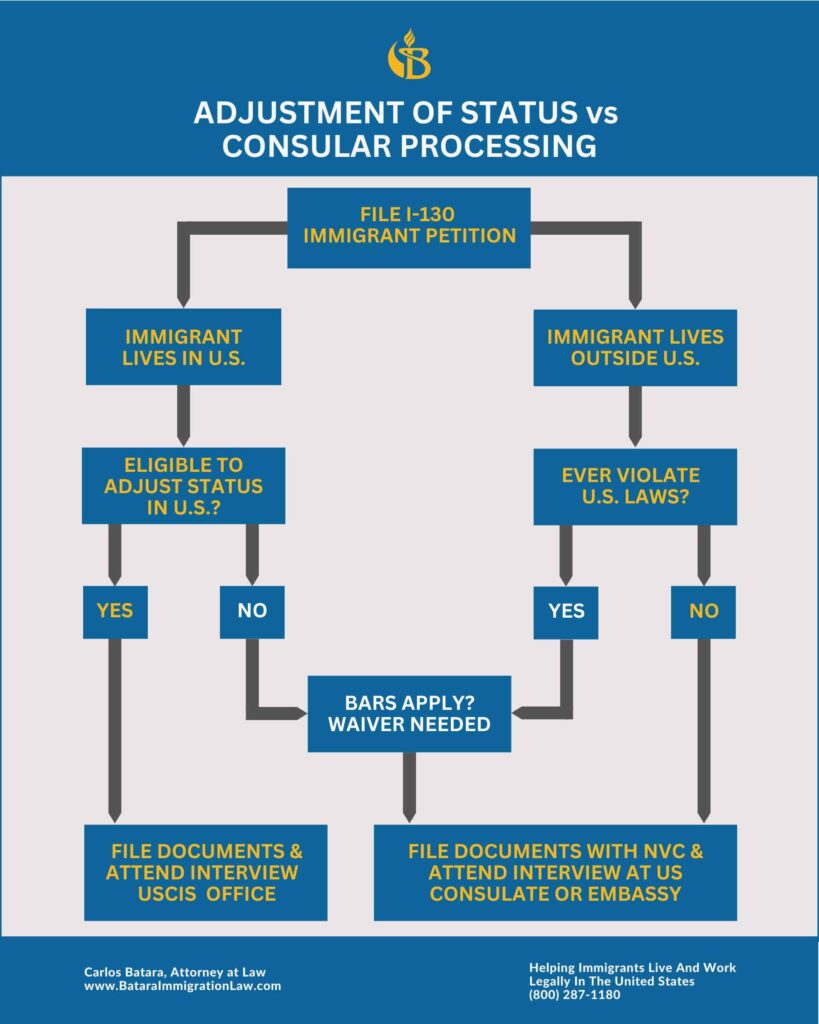
Only a small number of immigrants are eligible for both adjustment of status and consular processing.
However, green card applicants are not allowed to seek both consular processing and adjustment of status at the same time. Rather, they must choose only one or the other option.
5. Are There Any One-Step Adjustment Of Status Permanent Residence Applications?
No.
However, some immigrants can submit both the family visa petition and the permanent residence application at the same time. This is known as concurrent filing and is often referred to as one-step filing. (It’s not the same as a one-step application.)
In other words, to win a family immigration green card involves a two-step permanent residence process.
To qualify, an immigrant must be the immediate relative of a United States citizen.
Only the following immigrants are classified as an immediate relatives:
- Spouse of a U.S. citizen
- Child of a U.S. citizen
- Parent of a U.S. citizen, if the citizen is 21 years or older
This is an important point to understand.
Why?
Visas are always available for immediate relatives. This means once the family-based petition is approved, the second step, filing an the application to adjust your status to permanent resident, can begin. These cases move quickly.
Immigrants who are not immediate relatives must seek permanent residence under one of the family visa preference categories.
In some instances, if an immigration office is extremely busy, there may be a delay even for immediate relatives. But in general, their cases move faster than applications under the visa preference system.
Also, be aware that there are special meanings for who qualifies as a spouse or child. For instance:
- An immigrant common law spouse may meet the requirements for spouse
- Step-children and adopted children likewise have distinct rules for qualifying as children
6. Visas vs Green Cards: What Is The Difference?
Since “visas” and “green cards” have similar meanings, it’s easy to get confused over their differences.
Here’s a tip.
Consider the example where an immigrant spouse, after a family immigration petition has been approved, is coming into the United States.
In this situation, the immigrant does not become a permanent resident (“a green card holder”) until he receives an immigrant visa and uses it to enter the United States.
Likewise, if you’re applying for permanent residence from inside the U.S., you cannot become a permanent resident until a visa number is allotted to you.
Thus, when you hear about visas, it normally means an immigrant has the right to a green card – but does not have the actual green card yet.
Now let’s put it all together.
When a priority date becomes current, the waiting period is over. A visa is available for the immigrant. He can promptly apply for a green card. This means he is seeking to become a lawful permanent resident.
(Note: There is another type of visa. These are called nonimmigrant visas. They are used by immigrants entering the U.S. for a limited period, such as tourist visas, business visas, student visas, and the Visa Waiver Program.
7. Permanent Residence For Immigrant Children Of Your Spouse
What if your spouse has immigrant children from a previous marriage?
- If your spouse is an immediate relative, you will need to file a separate petition for them as stepchildren.
- If you are filing a marriage-based petition for your wife who is not an immediate relative, you can immigrate her children as derivative beneficiaries – as long as the child qualifies under one of the family visa preference classes.
8. What Happens While Your Permanent Residence Application Is Pending?
For immigrants in certain immigrant family preference classes, the delay for a green card interview can take 10, 15, 20 years or longer.
If they are living in the United States, this puts them at risk, while waiting, for being picked up by immigration law enforcement officers. They might be sent to immigration court to face deportation proceedings.
In the past, immigration officials indicated they would not pursue deportation or removal of certain immigrants who have petitions for immigrant family visas already filed. This policy shifted under the Trump administration.
Under President Biden, there has been a return to the more lenient policy.
Under such an approach, you can request prosecutorial discretion and ask the court to administratively close your case. Being sponsored for family immigration permanent residence is, generally speaking, a positive factor in such cases.
If your interview for a green card is coming up in the near future, this may enable you to avoid the immigration court process.
9. What Happens If You Win A Green Card As A Conditional Permanent Resident?
For some immigrants, earning permanent residence status is the end of the road.
But if you were granted permanent resident status less than two years after your marriage, you will win what is known as conditional permanent residence.
(This happens most commonly in cases where an immigrant spouse entered the U.S. on a fiance visa.)
For the next two years after being granted this status, you will have the same rights of a regular green card holder. You can work, go to school, and travel outside the country.
However, at the end of the two years, you have to again prove that your marriage is authentic. You will need to file a petition to remove the conditions on your green card.
For a full listing of questions asked by clients, see: Green Cards And Permanent Resident Questions And Answers.
10. After Becoming A Permanent Resident, When Can You File For U.S. Citizenship?
You many want to become a naturalized citizen. In general, if you are 18 years or older, you can begin the quest to naturalize once you have been a lawful permanent resident for five years.
However, if your green card was based on a petition filed by a U.S. citizen spouse, you only need to wait three years after the date permanent residency was granted.
To learn more about the naturalization process, here is our guide to winning citizenship, the final step of your immigration journey to live and work in the United States.
11. What If Your Permanent Residence Application Is Denied?
There is also the possibility your effort to become a lawful permanent resident is rejected at your green card interview.
The government may, at that point, decide to send your case to immigration court to face deportation charges.
However, all hope is not lost. You are given 30 days to challenge the denial.
There are various ways to challenge a denial of your green card application.
But you must take the proper steps to preserve this right.
By contesting the denial, the decision is not considered final, and your case will not be referred to immigration court.
It is important to note that should if I-485 application to become a green card holder is not granted, you cannot directly appeal the decision.
Instead, you are only allowed to file motions to reopen and motions to reconsider the negative USCIS decision.
If your motions are denied, at that point, the government will likely send your case to immigration court.
These cases are far too risky to handle on your own. You are strongly encouraged to seek the help of an immigration expert on deportation defense in such situations.
Conclusion: How To Avoid Stumbling Blocks That Affect Permanent Residence Success
To reiterate, immigrants who seek family-based permanent residence need to be alert for potential pitfalls arising before, during, and after the green card process runs its’ course.
The articles listed below provide additional pointers how to survive such challenges:
Ready to take a serious and honest look at the strengths and weaknesses of your immigration case? Let’s get started with a personalized strategy and planning session . . .
